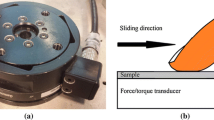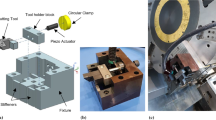Abstract
Friction reduction was investigated by making textured surfaces on outer cylindrical surfaces. The textured surfaces were manufactured by a piezoelectric tool holder actuator (PTHA), which was assembled in a lathe machine. Experimental and mathematical investigations were carried out. The experiments were carried out to investigate whether or not the textured surfaces could improve the lubrication performance of a cylindrical-contact planar surface. The textured surfaces were made on aluminum 6061 and carbon steel 1045 using vibration frequencies ranging from 50 Hz to 250 Hz. A block-on-ring tribometer was used in the experiments. A normal load of 50 N was applied with rotation speeds between 100 rpm and 1000 rpm. The experimental results show that the textured surfaces reduce the coefficient of friction by 20 to 40%. Also, this paper points out the limitation of the PTHA in fabricating various shapes as in the other methods.
Similar content being viewed by others
Abbreviations
- KZ :
-
total stiffness of parallel flexure bar
- KB :
-
local bending stiffness of asymmetric flexure hinge
- r:
-
magnification ratio
- l:
-
length between two asymmetric flexure hinges
- Sd(%):
-
density of micro dimple in contact area
- AD :
-
micro dimple area
- ND :
-
estimated number of micro dimples
- AC :
-
contact area
- LC :
-
length of contact area in sliding direction
- LF :
-
length of contact area in feed direction
- L:
-
imaginary length of square cell
- fm :
-
vibration frequency
- D:
-
diameter of workpiece
- int:
-
rounded integer
- F:
-
feed
- N:
-
rotational speed
- ho :
-
minimum thickness of fluid film
- hm :
-
maximum depth of the micro dimple
- h(x,y):
-
fluid film functions of x and y
- H:
-
dimensionless fluid film thickness
- p:
-
pressure
- P:
-
dimensionless pressure
- Po :
-
ambient pressure, 0.101325 MPa
- μ:
-
lubricant viscosity
- U:
-
sliding speed or fluid film velocity
- n:
-
minor diameter of micro dimple
- m:
-
major diameter of micro dimple
References
Zhang, J. and Meng, Y., “A Study of Surface Texturing of Carbon Steel by Photochemical Machining,” Journal of Materials Processing Technology, Vol. 212, No. 10, pp. 2133–2140, 2012.
Byun, J. W., Shin, H. S., Kwon, M. H., Kim, B. H., and Chu, C. N., “Surface Texturing by Micro ECM for Friction Reduction,” Int. J. Precis. Eng. Manuf., Vol. 11, No. 5, pp. 747–753, 2010.
Wang, Z. W., Chen, M. W., Wu, J. W., Zheng, H. H., and Zheng, X. F., “A Review of Surface Texture of Tribological Interfaces,” Applied Mechanics and Materials, Vol. 37, No. pp. 41–45, 2010.
Erdemir, A., “Review of Engineered Tribological Interfaces for Improved Boundary Lubrication,” Tribology International, Vol. 38, No. 3, pp. 249–256, 2005.
Etsion, I., “State of the Art in Laser Surface Texturing,” Journal of Tribology, Vol. 127, No. 1, pp. 248–253, 2005.
Etsion, I. and Sher, E., “Improving Fuel Efficiency with Laser Surface Textured Piston Rings,” Tribology International, Vol. 42, No. 4, pp. 542–547, 2009.
Wan, Y. and Xiong, D. S., “The Effect of Laser Surface Texturing on Frictional Performance of Face Seal,” Journal of Materials Processing Technology, Vol. 197, No. 1, pp. 96–100, 2008.
Gao, Y., Wu, B., Zhou, Y., and Tao, S., “A two-Step Nanosecond Laser Surface Texturing Process with Smooth Surface Finish,” Applied Surface Science, Vol. 257, No. 23, pp. 9960–9967, 2011.
Vilhena, L. M., Sedlaèek, M., Podgornik, B., Vižintin, J., Babnik, A., and Možina, J., “Surface Texturing by Pulsed ND: YAG Laser,” Tribology International, Vol. 42, No. 10, pp. 1496–1504, 2009.
Balasubramaniam, R., Krishnan, J., and Ramakrishnan, N., “A Study on the Shape of the Surface Generated by Abrasive Jet Machining,” Journal of Materials Processing Technology, Vol. 121, No. 1, pp. 102–106, 2002.
Wakuda, M., Yamauchi, Y., Kanzaki, S., and Yasuda, Y., “Effect of Surface Texturing on Friction Reduction between Ceramic and Steel Materials under Lubricated Sliding Contact,” Wear, Vol. 254, No. 3, pp. 356–363, 2003.
Zhou, R., Cao, J., Wang, Q. J., Meng, F., Zimowski, K., and Xia, Z. C., “Effect of EDT Surface Texturing on Tribological Behavior of Aluminum Sheet,” Journal of Materials Processing Technology, Vol. 211, No. 10, pp. 1643–1649, 2011.
Pettersson, U. and Jacobson, S., “Influence of Surface Texture on Boundary Lubricated Sliding Contacts,” Tribology International, Vol. 36, No. 11, pp. 857–864, 2003.
Kurniawan, R. and Ko, T. J., “A Study of Surface Texturing using Piezoelectric Tool Holder Actuator on Conventional CNC Turning,” Int. J. Precis. Eng. Manuf., Vol. 14, No. 2, pp. 199–206, 2013.
Yu, H., Wang, X., and Zhou, F., “Geometric Shape Effects of Surface Texture on the Generation of Hydrodynamic Pressure between Conformal Contacting Surfaces,” Tribology Letters, Vol. 37, No. 2, pp. 123–130, 2010.
Yuan, S., Huang, W., and Wang, X., “Orientation Effects of Micro- Grooves on Sliding Surfaces,” Tribology International, Vol. 44, No. 9, pp. 1047–1054, 2011.
Ronen, A., Etsion, I., and Kligerman, Y., “Friction-Reducing Surface- Texturing in Reciprocating Automotive Components,” Tribology Transactions, Vol. 44, No. 3, pp. 359–366, 2001.
Wang, X., Adachi, K., Otsuka, K., and Kato, K., “Optimization of the Surface Texture for Silicon Carbide Sliding in Water,” Applied Surface Science, Vol. 253, No. 3, pp. 1282–1286, 2006.
Etsion, I., Kligerman, Y., and Halperin, G., “Analytical and Experimental Investigation of Laser-Textured Mechanical Seal Faces,” Tribology Transactions, Vol. 42, No. 3, pp. 511–516, 1999.
Brizmer, V., Kligerman, Y., and Etsion, I., “A Laser Surface Textured Parallel Thrust Bearing,” Tribology Transactions, Vol. 46, No. 3, pp. 397–403, 2003.
Uehara, Y., Wakuda, M., Yamauchi, Y., Kanzaki, S., and Sakaguchi, S., “Tribological Properties of Dimpled Silicon Nitride under Oil Lubrication,” Journal of the European Ceramic Society, Vol. 24, No. 2, pp. 369–373, 2004.
Tang, W., Zhou, Y., Zhu, H., and Yang, H., “The Effect of Surface Texturing on Reducing the Friction and Wear of Steel under Lubricated Sliding Contact,” Applied Surface Science, Vol. 273, pp. 199–204, 2013.
Wang, X., Kato, K., Adachi, K., and Aizawa, K., “Loads Carrying Capacity Map for the Surface Texture Design of Sic Thrust Bearing Sliding in Water,” Tribology International, Vol. 36, No. 3, pp. 189–197, 2003.
Etsion, I., “Modeling of Surface Texturing in Hydrodynamic Lubrication,” Friction, Vol. 1, No. 3, pp. 195–209, 2013.
Author information
Authors and Affiliations
Corresponding author
Rights and permissions
About this article
Cite this article
Kurniawan, R., Ko, T.J. Friction reduction on cylindrical surfaces by texturing with a piezoelectric actuated tool holder. Int. J. Precis. Eng. Manuf. 16, 861–868 (2015). https://doi.org/10.1007/s12541-015-0113-2
Received:
Revised:
Accepted:
Published:
Issue Date:
DOI: https://doi.org/10.1007/s12541-015-0113-2




